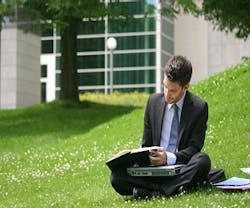10 Tips for Greening Your Building
Environmental sustainability. Green building. LEED. The facility management and building ownership landscape is filled with new ways to create energy efficient and environmentally sustainable buildings. KIMBERLY-CLARK PROFSSIONAL* offers ten tips and takeaways used for their headquarters building, Building 100 in Roswell, GA to achieve certification under the U.S. Green Building Council’s Leadership in Energy and Environmental Design (LEED) green building program.
1. Form a project team – When we began working toward LEED certification for our 30-year-old, 80,000-square foot facility, the first thing we did was establish a project team. The team included a third-party consultant with expertise in standards interpretation and policy development, a project administrator, a group of facility operations subject matter experts and outside vendors. Vendors included the facility’s landscape management firm, cleaning contractor and building services contractor.
2. Identify goals – After assessing the current state of your building, prioritize your goals. In our case, we were pursuing LEED green building certification and knew that our overall goal was to use less energy, water and natural resources. Consider tackling objectives with easy-to-implement modifications first, to gather momentum for the overall project.
3. Develop a building operating plan - By reviewing the operations, monitoring and maintenance of all heating, ventilating, air conditioning equipment and lighting, improvements can be made to daily operation practices to conserve energy, reduce maintenance and increase the life of equipment.
4. Practice sustainable purchasing – Start by examining the whole lifecycle of products that are purchased for use in the maintenance and operation of your building, from source to disposal. Look for new ways to reduce the amount of natural resources utilized in the building and remember that focusing on the recycled content of a product alone doesn’t look at the whole picture.
5. Maximize water efficiency - Replace old plumbing fixtures and materials with those that meet water-efficient, high-performance plumbing standards and install irrigation systems that utilize storm water for landscape watering.
6. Steward the natural environment – Use minimum quantities of the least toxic pesticides available, with preferences for non-chemical methods of pest control such as using adapted plant material to provide pest resistance. Choose native and adaptive plants, trees and shrubs that require no fertilizer.
7. Commit to green cleaning - Create a Green Cleaning Program to address the use of chemical concentrates and sustainable cleaning products and materials. Make sure staff is trained on green cleaning practices and policies.
8. Conduct an audit of the consumable waste stream – Use the results to identify opportunities for increased recycling and waste diversion.
9. Challenge employees and tenants to meet green goals - Sustainability programs have been shown to motivate existing employees and generate greater interest from prospective tenants. Communicate your green goals to employees and tenants and encourage participation in sustainability programs throughout your organization.
10. Measure the impact and celebrate – The results of “greening up” your building may vary depending on your goals, but we exceeded our own goals and expectations when our facility became LEED Certified under the LEED for Existing Buildings: Operations & Maintenance program. We take pride in our building and in our commitment to future generations.
